Marker has built a reputation for building alpine bindings with superior performance. Typically that means downhill performance â as in a binding that delivers a solid connection between the boot and the ski, but also knows when to let go. Marker’s new Alpinist 2-pin tech bindings maintain the alpine connection, but this time the performance emphasis is on the uphill.
The Duke was Marker’s second binding designed for the world of earn your turns skiing, but the first one to catch fire. For a time it was even the heaviest backcountry binding available, but it held solid after dropping serious air. In contrast the Alpinist tips the scales at a mere 245 grams (8.6 oz) per foot. When it comes to uphill performance, which generally means efficiency, the basic comparison can be done with a scale. However, unless you’re rando racing, there’s more to the equation than 2-pin touring functionality, especially for recreational touring where compromises in weight are acceptable for conveniences like ski brakes. Marker’s Alpinist strikes a good balance in addressing those without ignoring weight. To be sure, weight is part of that equation, but there’s more to uphill efficiency than weight.
Ease of Entry
The Alpinist uses visual clues for aligned the toe inserts with pins. It isn’t as foolproof as alignment bumpers, but over the course of two ski tours was noticeably easier than the classic 2-pin entry that requires fiddling proficiency, but not as reliable as toes with bumpers. Two tabs on either side of the toe lever, plus two in front of the two pin arms give a good reference for lining the front of your boot sole to. Line up and press down with your toe and the two arms will snap into the toe inserts with a reassuring, tight feel. One caveat. I had little trouble clicking in except when my heel was raised, making it more likely to twist the boot while pressing down. When I kept my heel low when lining up the pins clamped my boot first time.
Tight ass toes
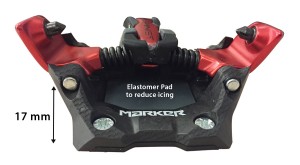
Two strong springs, a flexible toe pad, and high cantilever point yield solid 2-pin toe performance.
The heel unit
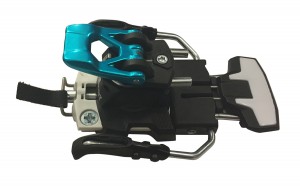
Heel of the Alpinist with brakes retracted. Flip the blue aluminum post forward to cover the heel pins for a 5° climbing post.
The Alpinst allows 4mm of dynamic length compensation. Thus, you position the heel to âkissâ the back of the boot, eliminating the need to maintain a calibrated gap. In addition the standard heel allows for 15mm of positional adjustment so you can use it with different boots, one with a shorter skimo race sole, or a longer, more traditional alpine sole with a full sized alpine DIN toe. It is also possible to get a demo binding with 35mm of adjustment range and a minor weight penalty.
The heel is not elevated, yielding a neutral ramp angle. If you want ramp angle, you’ll need to shim the heel. Optional brakes are available in three sizes â 90, 105, and 115 millimeters wide – with the ability to lock them up when skinning. The brakes maintain a dedication to weight reduction, logging in at 90 grams per brake.
Uphill efficiency
Three climbing post heights are available: 9°, 5°, and the oft overlooked 0° option. To get the five-degree option, the climbing post on top of the heel flips forward to cover the downhill pins . It is enough lift for low angle skin tracks, nor too much for short stretches of flat terrain. For steeper lines, twist the heel 180 degrees and the anodized climbing aid lever flips back for a zero degree setting, or flip it forward for a nine-degree post. On two different tours, with a variety of skin track angles this seemed to be the preferred setting. Nine-degrees may not seem like enough for some of you, but the Alpinist was built with a heritage in the Alps were steep skin tracks are the exception, unlike the States where they seem to rule.A subtle but appreciated feature is the ability for the climbing post to stand vertically in an intermediate position making it super easy to flip between 0° and 9°. Sadly there is no easy way to switch between 5° and 9°; to do so you must rotate the heel, a transition that, in comparison, is inconvenient. However, fans of Dynafit legacy bindings might differ on the degree of inconvenience since they’re adept at rotating the heel with a ski pole.
Without a doubt the most noticeable factor in uphill efficiency with the Alpinist is the lack of weight â a mere 245 grams without brakes, 335 grams (12.5 oz.) with brakes. The key to trimming the fat is a toe unit with a polyamide base plate using long carbon fibers for extra strength. The pins securing the toe arms are pushed into position while the polymer is still soft, eliminating the need to drill the holes that would, by cutting the fibers, compromise durability.Immuninity from Ice
Part of the reason that Marker made the shift to two springs instead of six was to minimize the surface area of the springs for ice to grow under. On a tour in humid conditions no one in a group of 30+ skiers notice any ice buildup on the binding, testifying that the reduced spring surface area and the flexible elastomer pad behind the toe springs did in fact keep snow from building up there. Transitions were simple and easy.Summary
There are certainly pin bindings available that are lighter, but their feature set is limited â fewer climbing heights, no brake options, and they require proficiency in the classic 2-pin fiddle factor that the Alpinist circumvents. Marker’s Alpinist has three climbing heights, optional brakes and ski crampons, easy entry, reduced icing potential, and is competitively priced. Those who like ramp angle will need to shim the heel, and those who like high climbing posts will be disappointed. For lighter skiers, the Alpinist offers release values down to 4, or up to 12. If you need more than 12, saving weight isn’t your highest priority.
Available Fall 2018.
Marker
Alpinist 12
MSRP (est.): $395.00 (⬠320.00)
Weight/binding: 8.6 oz. (245 g)
Ski Brakes
Widths: 90/105/115 mm
Price (est.): $60.00 (⬠45.00),
Weight: 3 oz. (90 g)
Misc.: DIN 6 â 12, 15mm adjustment range,
Alpinist 9
MSRP (est): $370.00 (⬠300.00)
Weight/binding: 8.6 oz. (245 g)
Ski Brakes
Widths: 90/105/115 mm
Price (est.): $60.00 (⬠45.00),
Weight: 3 oz. (90 g)
Misc.: DIN 4 â 9, 15mm adjustment range,
Related Posts:
Marker Duke review
Marker Kingpin review
© 2018


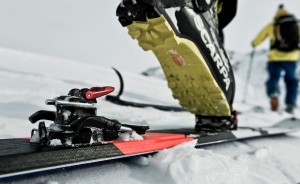
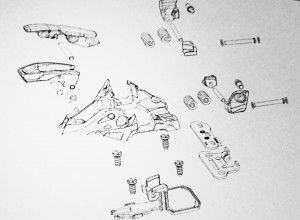
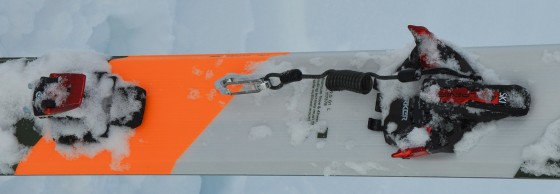
6 comments
Skip to comment form
Note even a mention about the release safety associated with a u-spring heel?
What holds the brake down, when in touring mode? Is that independent of heel rotation, as I think is implied? That’s nice, if so.
Hard to describe, but look at the back of the heel. That wire with the webbing strap toggles the brake lock mechanism. Back and it keeps the brake tangs up, forward and they deploy. So you toggle the wire fore/aft to lock/free the brake arms.
What is there to say? For many it is sufficient albiet a compromise compared to alpine resort bindings. If you don’t like that sort of heel retention/release then there are other options (Kingpin, Tecton) but none qualify as lightweight like the Alpinist does (or many other tech bindings). Or go tele and free the heel forever – half the binding, twice the fun. 😉
Given that tech heels have accepable, albiet inferior release characteristics, the Alpinist heel has continuous adjustable release laterally with a torx driver, and discreet adjustability vertically by swapping out the U-shaped spring bar. 3 stiffness bars available: Soft (~ DIN 5), Medium (~ DIN 7.5), and Hard (~ DIN 10.5). Alpinist 9 comes with Medium, Alpinist 12 with Hard.
Hmmm – is the hole pattern for the toe the same as the current Kingpin? I’d be really interested to go to Alpinist toes, then have QKs to be able to swap out for Kingpin heels for lift-served/short tours, and Alpinists for longer days/soft snow. Already slightly tempted to do this with Ions, but with the Alpinists one would save another 200g beyond Ion LTs, still have a dynamic heel, and only do a change with the heels once the toes were installed. Thanks for the review!